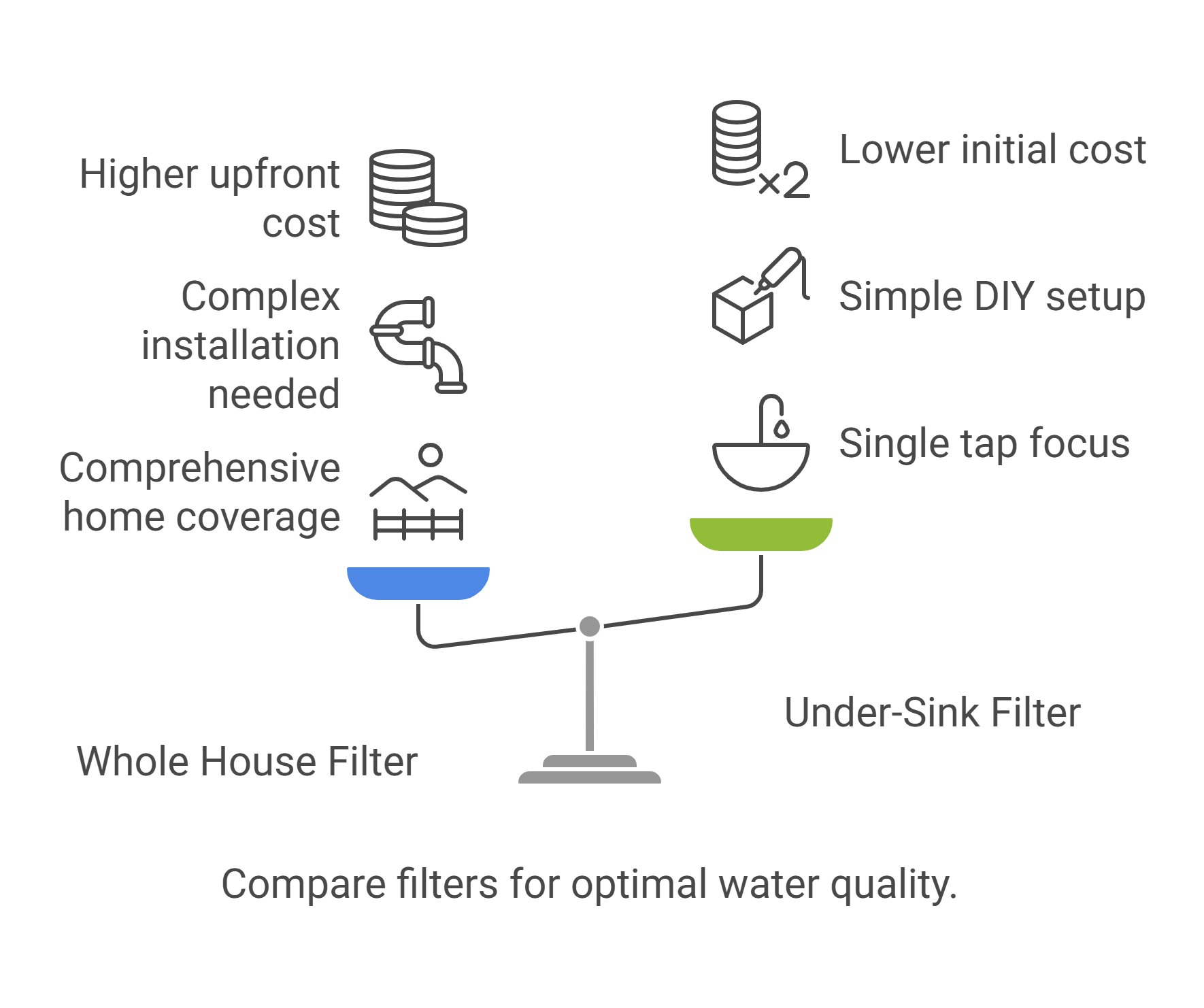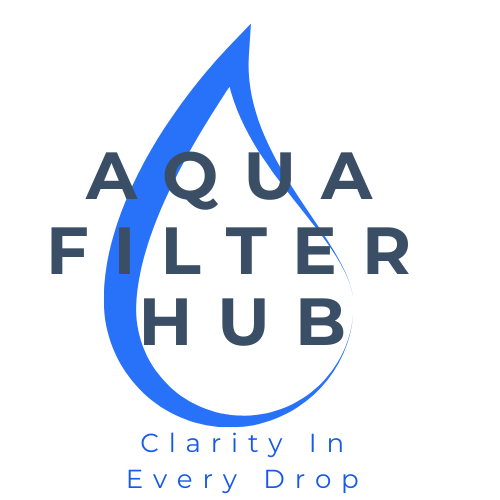Introduction
Have you ever stood by your kitchen sink wondering if there’s a better way to get clean, refreshing water? I certainly have. When I first started researching water filters, I was overwhelmed by the choices—especially when comparing whole house vs under sink water filters. Over time, I realized that while both have their strengths, the best choice depends on your unique needs. If you’re looking for more insights on water filtration systems, check out our Whole House Water Filters ultimate guide. Remember, we’re all about clarity in every drop!
A Tale of Two Systems: Understanding Your Options
Imagine coming home after a long day and turning on the tap to water so pure it reminds you of mountain springs. Clean water doesn’t just make your morning coffee taste better—it also protects your appliances, skin, and hair. Whether you live in the UK, US, or anywhere else, knowing the differences between whole house and under-sink water filters can save you time, money, and hassle while ensuring safe water for your family.
What’s the Difference? A Quick Primer
Before diving deeper, here’s a brief overview of the two systems:
- Whole House Water Filters:
These point-of-entry systems treat all the water entering your home. They are installed on your main water line and protect every faucet, shower, and appliance. For instance, the SpringWell CF1 Whole House Water Filter System has been a game-changer for many homeowners I know by reducing scale buildup and contaminants. - Under-Sink Water Filters:
These point-of-use systems are installed right under your sink—usually in the kitchen. They are designed to deliver ultra-clean water for drinking and cooking by removing contaminants like lead and chlorine. When I needed a reliable kitchen system, the Waterdrop 15UA Under Sink Water Filter System was an excellent, DIY-friendly option.
Both systems offer unique benefits and come with their own challenges. Let’s explore them further.
Whole House vs Under Sink Water Filters Detailed Comparison: Features, Costs, and Use Cases
Below is a side-by-side comparison that clearly outlines the key differences:
| Feature | Whole House Filter | Under-Sink Filter | What This Means For You |
|---|---|---|---|
| Coverage | Treats the entire home water supply | Focuses on water from one tap (usually the kitchen) | Use WHF for every faucet, shower, and appliance; under-sink if only drinking/cooking water matters. |
| Installation | More complex; professional help recommended (2–4 hrs) | DIY-friendly; simple connection under sink (30 min–1 hr) | Choose under-sink if renting or avoiding plumbing work; choose WHF if you own and want full-home protection. |
| Maintenance Frequency | Replace cartridge every 6–12 months | Replace cartridge every 3–6 months | WHF is lower-touch (“set & forget”); under-sink requires more regular checks. |
| Upfront Cost | £800–£2,500 for system & installation | £50–£200 per unit | Under-sink is budget-friendly initially; WHF is an investment in whole-home longevity. |
| Long-Term Cost | £100–£200/year (filter changes) | £60–£120/year (more frequent changes) | WHF often works out cheaper per gallon; under-sink costs add up if multiple taps. |
| Filtration Capability | Sediment, chlorine, some heavy metals | Often superior for lead, VOCs, pharmaceuticals | Match filter media to contaminants identified in your water test; consider dual systems if needed. |
| Impact on Water Pressure | Minimal—maintains consistent pressure | May slightly reduce flow at the tap | No noticeable change with WHF; under-sink might feel slower when filling large pots. |
| Compatibility with Softeners | Easily integrates with whole-home softeners | Rarely used with under-sink softening | If you have hard water, pair WHF with a softener; under-sink won’t protect appliances. |
| Best Use Case | Full-home protection (appliances, showers, faucets) | Drinking & cooking water quality | WHF for comprehensive protection; under-sink for focused drinking-water purity. |
Quick Comparison Summary: Whole House vs. Under-Sink Water Filters
Choosing between a whole house and an under-sink water filter depends on your specific needs and household priorities. Here’s a concise comparison to guide your decision:
- Whole House Water Filter: Ideal for comprehensive water treatment, ensuring that all water sources in your home—from showers to washing machines—receive filtered water. This system is beneficial for protecting plumbing and appliances from sediment and scale buildup.
- Under-Sink Water Filter: Best suited for targeting drinking and cooking water at a specific tap. These filters are typically easier to install and maintain, making them a cost-effective solution for improving water taste and safety at a single point of use.
For a more detailed breakdown, refer to the comparison table above.
Best Choice Scenarios: Which Filter Suits Your Needs?
Choose a Whole House Filter if…
- You own your home and want to protect all plumbing, appliances, and fixtures from sediment, chlorine, and scale buildup.
- You’ve noticed inconsistent water quality in showers or when doing laundry.
- You prefer a “set-and-forget” solution with fewer filter changes per year.
Choose an Under-Sink Filter if…
- You rent or plan to move soon and need a non-invasive, DIY installation.
- Your primary concern is the taste and safety of drinking and cooking water.
- You want a lower upfront cost and don’t mind changing cartridges more often.
Consider Both Systems if…
- You need full-home sediment/chlorine removal plus specialized contaminant reduction (lead, VOCs) at the kitchen tap.
- Water quality tests show multiple issues: hard water in pipes and heavy metals in drinking water.
- You’re willing to invest in long-term home protection and targeted drinking-water purification for optimal health and appliance longevity.

Real-Life Reviews & Expert Insights: What People Are Saying About These Systems
Real stories and professional insights can help you make the right decision when choosing between a whole house water filter and an under-sink model. Here’s what actual users and experts have experienced:
Real-Life Case Studies & Testimonials
🏠 Whole House Water Filter Experiences
1. Improved Skin and Hair Health
“Since I have had the whole house system in my house, my hair and skin health has improved.”
— Amy Ivey, via Water Science US Testimonials
2. Reduction in Skin Conditions
“After getting Pure Elements Water, our lives have changed! No more skin problems, hair problems, and my husband’s blood pressure has been going down (after we removed our salt water softener).”
— N.D., Rancho Mirage, CA, via Pure Elements Water Testimonials
3. Enhanced Water Taste and Appliance Protection
“We got Pure Elements filtration to prevent copper pipe leaks. We have been on it for about 5 years with no leaks (we had 3 leaks prior!). An additional upside is the water tastes fantastic, plus it removes toxins.”
— Dave L., Newport Beach, CA, via Pure Elements Water Testimonials
🚰 Under-Sink Water Filter Experiences
1. Improved Water Taste and Convenience
“Honestly, I can’t believe I didn’t install one sooner. The convenience factor is off the charts. From great-tasting water at my fingertips to a simple solution for cleaning produce and adding filtered water to recipes, this home purchase is a keeper.”
— Bob Vila, reviewing the iSpring Under Sink RO System on BobVila.com
2. Significant Improvement in Water Quality
“I noticed a significant improvement in the overall feel and taste of the water. Not only has Puralife provided me with top-notch customer service throughout the entire process, but their dedication to delivering high-quality products that truly make a difference in people’s lives is truly commendable.”
— Ashlin, East London, via PuraLife Water Filters Reviews
🧠 Expert Insights
Fred DeFelice, Master Plumber and Systems Designer
“We have had Fred install both the whole house system and the under the sink unit in our home and absolutely LOVE it! I highly recommend this system for so many reasons.”
— Kim Adams, Realtor, via Water Science US Testimonials
Rick Allen, Water Filtration Expert at Pure Elements Water
“We feel that installing the Pure Elements Water Filtration system is the most conservative and logical way to approach this widespread pinhole leak issue. Rick helped us realize that his filtration system is NOT like all other filtration systems out there, because his filtration system is actually customized to address the type of water and chemicals coming into your home in your community.”
— Bertina, Newport Coast, CA, via Pure Elements Water Testimonials
My Personal Journey with Water Filters
I still remember the day I first noticed an off taste in my coffee. I started asking questions, reading reviews, and testing different systems. I found that a whole house system—like the SpringWell CF1—offers comprehensive protection for every faucet, while an under-sink filter such as the Waterdrop 15UA is perfect for ensuring the water you drink and cook with is ultra-pure. Over time, I learned that most households don’t need both systems unless they face serious water quality issues. Focusing on what matters most—clean drinking water—can truly transform your everyday life.
Frequently Asked Questions (FAQs)
What’s the main difference between whole house and under-sink water filters?
Think of a whole house filter as your home’s first line of defense—it cleans every drop of water entering your house, from showers to dishwashers. An under-sink filter, on the other hand, targets drinking and cooking water from a single tap, offering ultra-clean water where it matters most.
Which system is more cost-effective in the long run?
Under-sink filters are budget-friendly upfront and great for renters or small households. But if you’re dealing with multiple water quality issues (chlorine, sediment, iron), a whole house system may offer better long-term value and fewer replacements, especially if you bundle it with a softener.
Do whole house filters remove chlorine and harmful chemicals?
Yes—most whole house systems reduce chlorine, chloramines, sediment, and even some VOCs. They’re perfect for improving the water in showers, washing machines, and dishwashers, while also extending the life of plumbing and appliances.
See our our chlorine removal guide here.
Can under-sink filters handle well water contaminants?
Absolutely. Many high-quality under-sink filters are designed for well water and can handle lead, iron, pesticides, and heavy sediment. Some models even include multi-stage filtration or UV purification for added safety.
See our well water guide here.
How often should I replace the filters?
It depends on water usage and filter type:
- Whole house filters: Typically every 3 to 6 months.
- Under-sink filters: Usually every 6 to 12 months. Check manufacturer guidelines, and if your water smells or tastes off, it’s probably time for a change.
See our filter replacement guide here
Is professional installation required?
- Whole house systems: Usually best installed by a plumber due to pipe integration.
- Under-sink systems: Designed for DIY installation with basic tools, making them ideal for homeowners who like simple projects.
Will these filters affect my water pressure?
- Whole house filters, when correctly sized, maintain strong water pressure.
- Under-sink filters may cause a minor drop at that tap, but it’s usually not noticeable in daily use.
Can I install both a whole house and under-sink system together?
Yes—and many do. Installing both gives you broad protection and targeted purification. Use a whole house filter to clean water for bathing, laundry, and appliances, and an under-sink filter for drinking and cooking.
Is an under-sink water filter enough?
Yes—for drinking and cooking needs, under-sink filters are great. But if you’re concerned about shower water, laundry, or plumbing protection, an under-sink system won’t cover those areas.
What are the disadvantages of a whole house water filter?
They can be more expensive upfront, require professional installation, and in rare cases, may slightly reduce pressure if not properly sized. However, they offer comprehensive protection for your entire home.
What are the disadvantages of under-sink water purifiers?
They only treat water from one faucet, so you won’t get protection in the shower or laundry. They may also need more frequent filter changes depending on your water
Top-Rated Product Recommendations
To help you make an informed decision, here are my top picks for each system—curated for performance and reliability:
Whole House Systems
- SpringWell CF1 Whole House Water Filter System
Comprehensive filtration that removes up to 99% of chlorine and contaminants, ensuring safe water throughout your home. - Aquasana EQ-1000 Whole House Water Filter System
A robust four-stage system combining carbon, KDF, and TAC for exceptional water quality.
Under-Sink Systems
- Waterdrop 15UA Under Sink Water Filter System
Designed for drinking and cooking water, it reduces lead, chlorine, and off-tastes with NSF/ANSI 42 certification. - iSpring RCC7AK 6-Stage Under Sink Reverse Osmosis System
A comprehensive six-stage RO system with alkaline remineralization, removing up to 99% of contaminants for refreshing water.
Wrapping It Up: Your Next Steps
Both whole house and under-sink water filters offer distinct advantages:
- Whole House Filters: Ideal for comprehensive home protection—safeguarding appliances and reducing overall contaminants.
- Under-Sink Filters: Perfect for ensuring that the water you drink and cook with is pristine.
Ultimately, your choice should reflect your specific water quality issues, lifestyle, and budget. I hope this article has helped clear the fog on what can feel like an overwhelming topic. Remember, achieving clarity in every drop isn’t just a tagline—it’s a promise for a healthier, happier home.

For more in-depth reviews and guides, visit our Whole House Water Filters ultimate guide.
Internal Links:
• How to Choose the Best Whole House Water Filter
External Resource:
For additional insights, check out Consumer Reports’ comparison on water filters at consumerreports.org.
Affiliate Disclosure:
Some links in this article are affiliate links, meaning we may earn a small commission at no extra cost to you. We only recommend products we truly trust and have personally vetted.
